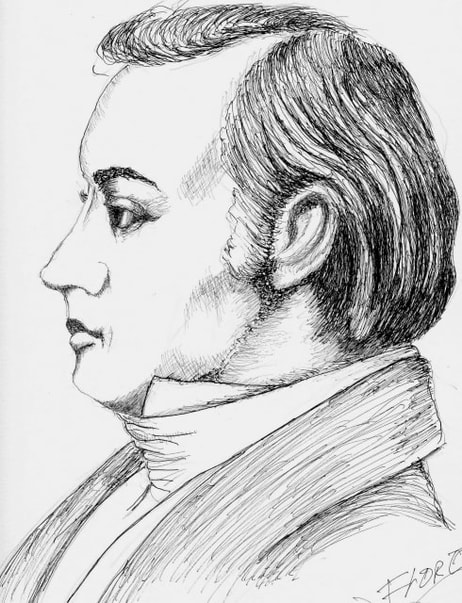Elijah Parish Lovejoy

Elijah Parish Lovejoy (1802-1837), a native of Albion, Maine, was murdered in Alton, Illinois by a pro-slavery mob on November 7, 1837 while defending his right to promote the abolition of slavery in the United States. His activity in support of abolition had been prominently on display in two local forums. The first was in his work as a Presbyterian minister. A graduate of Waterville (Colby) College and Princeton Theological Seminary, Lovejoy was ordained in St. Louis, Missouri, in 1834. In Missouri, he began to denounce slavery from his pulpit and in his newspaper. After a mob destroyed his printing press, he moved to Alton, Illinois. In Alton, he led the College Avenue Presbyterian Church and started a newspaper called the Alton Observer, which regularly featured his anti-slavery columns. Thus, he became a highly visible target for pro-slavery advocates.
Lovejoy's violent death, and the man himself, have been majestically characterized in a number of different ways including: ‘First battle of the Civil War,’ ‘Abolition’s Martyr,’ ‘A Martyr to Freedom of the Press,’ and ‘Champion of Freedom – for the African American and the Press.’ In his biography of Lovejoy, former U.S. Senator from Illinois Paul Simon wrote that Lovejoy was a man “whose death would electrify the nation.” It’s also been claimed that the singular events that most hastened onset of the Civil War were John Brown’s raid on Harper’s Ferry and Lovejoy’s martyrdom.
These are pretty strong claims for a man of relative obscurity today. Why is such importance attached to Lovejoy? First and foremost, he made the ultimate sacrifice in giving his life in support of abolition. He can also be seen as a hero in defense of publishing unpopular opinion, and his death occurred during an attempt to protect his printing machine during a fourth attack by mobs. However, publishing was only one of the means Lovejoy used to promote the ideals of human dignity and freedom. Second, Lovejoy’s death happened fairly early in the history of the abolition movement. Advocating the immediate abolition of slavery in the United States was gaining momentum during the 1830s as anti-slavery groups organized and started spreading their inspired word. Lovejoy’s killing was a harbinger of violent things to come, and of the personal commitment that would be required to hasten the end of slavery. Third, Lovejoy was a man of the cloth. His early participation in the abolition movement foretold a coming crisis of conscience among America's clergy. During the years following Lovejoy's death, abolition arguments would rock the foundations of American religion. Finally, Lovejoy’s martyrdom occurred in a special geographic setting relative to abolition and the Civil War. The prime elements of this locational vortex included the tumultuous border area environment between slave and free states (in his case Illinois and Missouri) as well as shared statehood with a similarly maturing individual who more than all others would come to represent the end of slavery– Abraham Lincoln.
Lovejoy's violent death, and the man himself, have been majestically characterized in a number of different ways including: ‘First battle of the Civil War,’ ‘Abolition’s Martyr,’ ‘A Martyr to Freedom of the Press,’ and ‘Champion of Freedom – for the African American and the Press.’ In his biography of Lovejoy, former U.S. Senator from Illinois Paul Simon wrote that Lovejoy was a man “whose death would electrify the nation.” It’s also been claimed that the singular events that most hastened onset of the Civil War were John Brown’s raid on Harper’s Ferry and Lovejoy’s martyrdom.
These are pretty strong claims for a man of relative obscurity today. Why is such importance attached to Lovejoy? First and foremost, he made the ultimate sacrifice in giving his life in support of abolition. He can also be seen as a hero in defense of publishing unpopular opinion, and his death occurred during an attempt to protect his printing machine during a fourth attack by mobs. However, publishing was only one of the means Lovejoy used to promote the ideals of human dignity and freedom. Second, Lovejoy’s death happened fairly early in the history of the abolition movement. Advocating the immediate abolition of slavery in the United States was gaining momentum during the 1830s as anti-slavery groups organized and started spreading their inspired word. Lovejoy’s killing was a harbinger of violent things to come, and of the personal commitment that would be required to hasten the end of slavery. Third, Lovejoy was a man of the cloth. His early participation in the abolition movement foretold a coming crisis of conscience among America's clergy. During the years following Lovejoy's death, abolition arguments would rock the foundations of American religion. Finally, Lovejoy’s martyrdom occurred in a special geographic setting relative to abolition and the Civil War. The prime elements of this locational vortex included the tumultuous border area environment between slave and free states (in his case Illinois and Missouri) as well as shared statehood with a similarly maturing individual who more than all others would come to represent the end of slavery– Abraham Lincoln.
Further information
|
Documents
Vertical Divider
|
Photos
|
Interested in more? Check out our mercantile!You can find video recordings of the ceremonies, as well as badges, books, buttons, magnets, mugs, and stationery at the Peterboro mercantile. Caps, tee shirts, journals, mugs, bags and more are available on NAHOF's cafepress shop.
|
